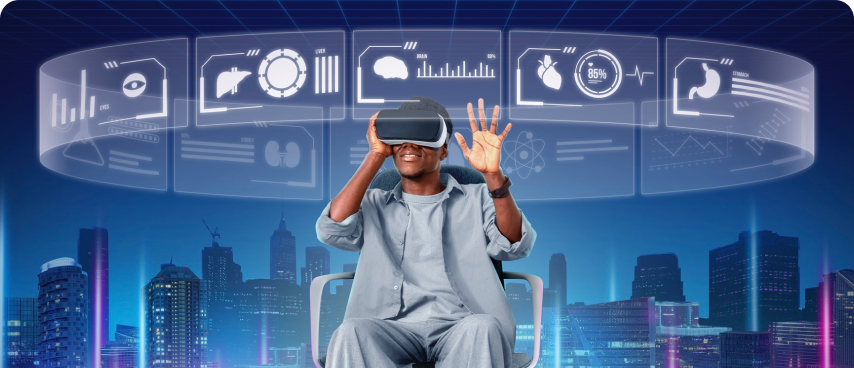 One tree
One tree One life


Elevate your business presence and build web apps with us that are responsive. We are a trusted web app development company with over 36 years of experience in building customized solutions in more than 40+ countries. Whether you are a small enterprise or a large corporation, grow your business with our web app development services and get an interactive and eye catchy website tailored for your business.
At SPEC INDIA we have a skilled web development team with experience in both front-end and back-end development, including databases. We provide complete web development services—from user-friendly design to powerful backend systems to all scale of business and all industry verticals. Here is a glimpse of our web app development services.

Your business is different, and so should the way it represents itself on the internet, like a website. Our custom web application development services are specifically tailored to address your requirements and objectives. From streamlined navigation to standout features, we create websites that are not only visually appealing but also work effectively.

We understand how vital your online store is for your business. That is why we create ecommerce websites that help companies sell more and streamline the purchasing process. From the simple and smooth process of checkout to integrated and highly secure forms of payment, your customers are covered.

Tired of your outdated website? Ready for a fresh look? Our design and redesign services are here to help. Whether you want to start from scratch or give your current site a new vibe, we focus on creating modern, user-friendly designs that not only attract visitors but keep them coming back.

Why struggle with complicated website updates? O Through our bespoke CMS solutions, we enable you to control all aspects of your website. We develop easy-to-use content management systems that enable you to make changes, add or remove content directly on your website effortlessly.

Deliver fast, reliable, and engaging web experiences with our Progressive Web App development services. We build Progressive web apps that combine the best of web and mobile apps—offering offline access, push notifications, and seamless performance across all devices. Our expert team of web app developers ensures that you get secure, scalable, and high-performing PWAs customized to your business needs.

Developing a web application isn’t just about writing code—it’s about making the right choices from the start. Our web app consulting services help you navigate the complexities of development, from selecting the best technology stack to designing an architecture that ensures scalability and security. We are here to help you at each step.

Modern users expect speed, responsiveness, and seamless interactions. That’s where Single Page Applications (SPAs) shine. We specialize in developing high-performance SPAs using leading frameworks like React, Angular, and Vue.js. These apps load quickly, feel incredibly smooth, and deliver a native app-like experience to your users which will make then engaged to the app.

Your enterprise needs more than just a basic web application. It requires a robust, secure, and scalable solution that can support complex workflows and business operations. Our enterprise web applications are designed to improve efficiency, integrate seamlessly with your existing systems, and adapt as your business grows. Our team of experienced developers are here to help you out.

In today's world, making your website responsive is essential, and that means your website must look perfect on any device. We are among the best web development companies worldwide and our web development team creates sites that look good and function well on any device – including smartphones, tablets, and computers. No more pinching and zooming!

Outdated web apps can slow down operations, pose security risks, and limit growth. We upgrade legacy systems by modernizing outdated technologies, enhancing performance, and improving user experience. All with minimal disruption. From migrating to modern frameworks to optimizing security and scalability, we ensure your web app stays future-ready and efficient.

At SPEC INDIA, We Bring Your Ideas to Life with a Clear, Collaborative Process. Work with a partner who listens and understands your business needs from the start while keeping your budget in check.
Let’s have a healthy conversation, as it costs nothing!
React is a popular JavaScript library for building user interfaces. It is a top-rated cross-platform, flexible, and open-source library maintained by Meta. It is one of the most commonly used frontend libraries for web and mobile. We also build cross-platform apps using React Native, a popular cross-platform mobile app framework for building apps for iOS and Android.
Built on TypeScript, Angular is a component-based, open-source web application framework by Google. Our Angular development services serve businesses of all sizes and deliver tailored-fit solutions. Our expertise in Angular web development delivers customized, scalable, and high-quality web applications, web portals, SPAs, and dynamic web apps.
Vue is a modern JavaScript framework to build captivating user interfaces with intuitive API, powerful features, and a declarative and component-based programming model. Vue.js is considered one of the top front-end UI frameworks and is loved by developers and businesses alike. It is versatile and used to create web user interfaces that are truly native and visually rich.
HyperText Markup Language is one of the core technologies for creating web pages. HTML is the foundation of all web pages and is often used with CSS and JavaScript to write pages to be displayed in a web browser. Our experienced web developers craft responsive, intuitive, user-friendly, and interactive web and mobile app user interfaces.
Cascading Style Sheets (CSS) is a stylesheet language used to style HTML elements. It describes how HTML components should appear in a document. It is used along with HTML and JavaScript and is considered one of the important technologies in the foundation of the web. CSS is widely used in front-end web development for web styling.
.NET is an open-source and cross-platform framework developed by Microsoft. It is used to develop many types of applications such as web, mobile, cloud, mobile, desktop, and IoT. It is the first choice of developers to build scalable, secure, and faster web applications. Our .Net development expertise will cater to the needs of modern businesses by creating high-quality software solutions.
Popular for its suitability for web development, PHP is a widely-used, open-source scripting language. It is easily embedded into HTML and powers a large number of websites across different industry segments worldwide. It is a fast, flexible, and pragmatic language with a large community of developers and contributors across the world.
Java is one of the most popular and widely-used programming languages famous for its versatility, stability, compatibility, and resiliency. Java is a go-to language for enterprise software as it is great for scalability, has a huge ecosystem of libraries and frameworks, and works well for any type of software development be it cloud, AI, microservices, and IoT.
Simple, concise, and powerful – these words sum up Python, a popular programming language used for data analysis, web development, cross-platform applications, and handling big data requirements. It is a top choice for data science owing to its simplicity, performance, and suitability for executing complex mathematics requirements.
NodeJS is an open-source, cross-platform JavaScript runtime and very popular for almost any type of project. Our Nodejs development services include developing web applications that are scalable and capable of handling a large volume of users. Node.js is favorable for API development, microservices, scalable network applications, and faster web apps.

MySQL is a free and open-source relational database management system suitable for data warehousing needs and large online transaction processing (OLTP). Boost performance and achieve agility, reliability, and uptime with the MySQL platform. MySQL is one of the widely-used databases and meets almost all the requirements of today’s businesses.

We help modern businesses streamline data collection, data migration, and data integration using powerful tools and technologies. SQL Server offers many features for data collection, integration, management, analysis, and reporting. Microsoft SQL Server is a relational database management system ideal for server applications.
Oracle SQL is a multi-model database management system developed and maintained by Oracle Corporation. It is used for running data warehousing, online transaction processing, and database workloads. Oracle SQL offers easy and robust architecture for accessing, maintaining, and refining data.

PostgreSQL is a powerful, open-source RDBMS offering extensibility, advanced features, and SQL compliance. We work with PostgreSQL to address your data warehouse and data storage needs with its robust features such as stability, high levels of resilience, integrity, and accuracy.
MongoDB is a NoSQL and cross-platform database used extensively by developers to create highly available and scalable applications. It is a popular document database based on JSON-like documents that power faster, flexible, and performant applications. Our developers are well-versed with database technologies, data platforms, and analytics platforms that allow them to solve complex data challenges.
Laravel is the most popular PHP web framework designed for creating powerful, full-stack PHP web applications. It offers elegant, expressive, and clean syntax that improves the developer experience and makes development faster. Our Laravel developers are committed to delivering the finest web applications that are scalable, well-architected, and high-performing.
Spring is the most popular application development framework for enterprise Java development. SPEC INDIA’s experienced Java developers use Spring to create scalable, feature-rich, and high-performing Java applications. Spring is a very suitable framework for complex Java enterprise applications for a wide range of scenarios and domains.
Django is a high-level Python web framework that makes development easier and faster. It is an extremely popular web framework widely used to develop scalable and maintainable websites using Python. With its well-designed features and functionalities, Django is a versatile, open-source web framework with a thriving community and support.
Express.js is a backend web application framework widely used for building web applications and APIs. It is known as a server framework for Node.js and one of the core components of the MEAN stack. Express.js comes equipped with fundamental web features that make it a fast, minimalist, flexible Node.js framework.

Azure, a cloud computing service from Microsoft helps organizations save costs, and build secure, future-ready cloud solutions. Microsoft Azure offers a range of products and services to set up a cloud environment and modernize applications with advanced capabilities to manage data, infrastructure, and workloads.

We work with leading and widely-used cloud computing services that power a large number of businesses across the world. AWS offers a highly reliable, scalable, and low-cost infrastructure through various models and on-demand cloud computing platforms based on a pay-as-you-go pricing structure.

Google Cloud Platform offers reliable, high-performance, and scalable infrastructure to build, deploy, and scale apps, websites, and services. GCP is a popular cloud service provider providing flexible infrastructure, scalability, security, powerful analytics, and easy deployment to modernize and transform businesses.

Docker is a software platform that allows developers to build, test, and deploy applications with containerization. Docker packages software into units that have the necessary libraries, tools, and code to run the software. It is a very popular modern concept and widely used tool by developers to accelerate software development and deployment.
Kubernetes is an open-source container orchestration platform for automating the deployment, scaling, and management of containerized applications. It manages the availability of many physical and virtual hosts that manage a large number of containerized applications. It automates many manual processes of deploying, managing, and scaling applications.
At SPEC INDIA, we build web apps that not only look great but also work smoothly. Whether it's a simple website or a complex web app, our team is here to bring your ideas to life. We ensure that your website is easy to use, secure, and ready to grow with your business. Here is why you should trust us as your web application development company!
With over 30 years of experience, we know what it takes to build great websites. Our team has worked with businesses of all sizes, delivering web solutions that are fast, secure, and reliable. When you work with us, you’re choosing experts who understand what works best for your industry.
We don’t just create websites—we create solutions that fit your business. We take the time to listen to your goals, understand your audience, and build a website that meets your expectations. Your success is our priority, and we make sure you're satisfied at every step.
Our work doesn’t stop once your website goes live. We provide ongoing support to keep your site secure, updated, and running smoothly. If you ever need help or improvements, we’re always here to assist you.
We work with clients worldwide, so we know how to create websites that connect with different audiences. Whether you need multiple language support, region-specific features, or compliance with international standards, we’ve got you covered.
We build websites that are not only visually appealing but also strong and secure. From fast-loading pages to advanced security features, we ensure your website performs well and protects your data.
The digital world is always changing, and we stay ahead of the trends. We use the latest tools and technologies to make sure your website is modern, efficient, and ready for the future. Whether it’s AI-powered features, cloud-based solutions, or interactive design, we bring the best to your business.
Our dedicated web app developers offer flexible, tailored, and full-cycle web solutions in an array of business domains following modern project development methods and ensuring the best possible outcome.
Hire Team Now

Step into the future of secure and decentralized digital experiences. Our Web3 and blockchain-based web applications are built to offer unmatched transparency, trust, and autonomy. Whether you're building a fintech platform that handles sensitive transactions, a supply chain system that needs traceability, or a digital identity solution that empowers user ownership—blockchain brings tamper-proof data records, decentralized ledgers, and smart contract automation to your web infrastructure.
Explore Further
Modern businesses need modern infrastructure—and cloud-based web solutions deliver exactly that. Our cloud-powered web development services ensure your website or web app is fast, highly scalable, and available round the clock. With integrated cloud platforms like AWS, Azure, and Google Cloud, we build solutions that handle heavy traffic, support remote workforces, and auto-scale as your business grows. Whether it's a SaaS product, ecommerce site, or internal enterprise app, cloud integration ensures performance and resilience.
Explore Further
Turn data from connected devices into meaningful, real-time insights with intuitive, web-based dashboards. We build smart web interfaces for IoT applications that let users monitor, manage, and analyze devices remotely—from anywhere, on any device. Whether you're managing a fleet of smart meters, home security systems, or manufacturing equipment, our IoT web solutions make sure your users stay informed and in control.
Explore More
Why just show your products when you can bring them to life? With AR/VR integrated into your website, we help you deliver engaging, interactive, and futuristic experiences directly from the browser. Perfect for industries like retail, education, gaming, and real estate, AR/VR features can transform static pages into immersive journeys—think 360° property tours, virtual classrooms, or digital fitting rooms, all accessible without leaving your site.
Explore Further
Enhance your customer support with AI-driven chatbots that are smart, responsive, and available 24/7. Our chatbots integrate smoothly into websites, mobile apps, and even messaging platforms like WhatsApp and Facebook Messenger. They can answer FAQs, help with orders, book appointments, or guide users through services—all while reducing your human support load and operational costs.
Explore Further
Harness the power of artificial intelligence to build smarter web applications that learn, adapt, and deliver personalized experiences. Our AI-powered web development covers everything from intelligent search and recommendation systems to predictive analytics and fraud detection tools. Whether you're running an eCommerce store, a finance portal, or an enterprise platform, AI helps you streamline workflows, understand user behavior, and make data-backed decisions in real time.
Explore MoreDiscover the diverse range of industries we proudly support with our innovative software solutions to companies of different business verticals. Our expertise spans multiple sectors, ensuring tailored services for every unique need.
“SPEC House”, Parth Complex, Near Swastik Cross Roads, Navarangpura, Ahmedabad 380009, INDIA.
“SPEC Partner”, 350 Grove Street, Bridgewater, NJ 08807, United States.
This website uses cookies to ensure you get the best experience on our website. Learn more